All about garlic
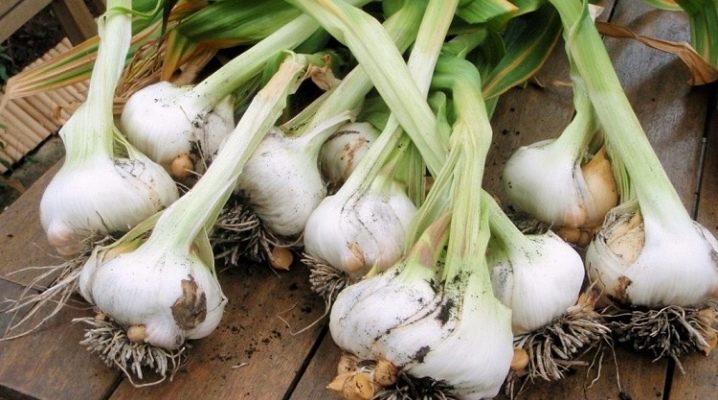
Experienced can be considered only those gardeners and gardeners who know everything about garlic, about what the plant family is, what is the difference between solo garlic, sowing and spring types. It is important to find out what the head and clove look like, how garlic multiplies. And you also need to pay attention to planting, caring for this plant and its reproduction.
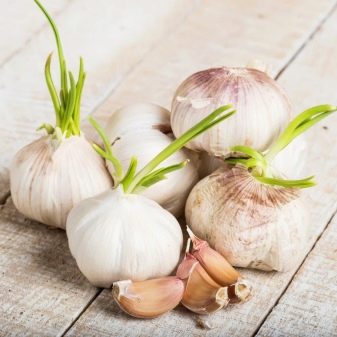
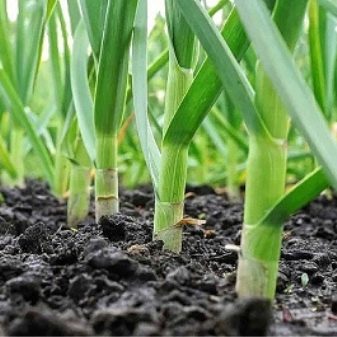
general description
It should be noted right away that garlic is a perennial herb. It belongs to the genus onion from the amaryllis family of the order of the asparagus monocotyledonous class. In addition to different types of onion, its botanical relatives are snowdrop and daffodil. The pungent taste and specific smell of garlic makes it very interesting from a culinary point of view. Therefore, this culture is actively planted in various countries.
The garlic bulb is a culinary fruit only. According to botanical criteria, it is a modified shoot. The bulb itself is divided into fragments (heads), which are excellent seeds. Leaves, arrows and flower stalks can also be edible. They are collected mainly from young garlic shoots. It is curious that the very name of the plant in Russian goes back to the most ancient words with the meaning "divide, split".
The conclusion is simple - thousands of years ago, people paid attention primarily to the properties of the bulb. From a botanical point of view, garlic belongs to the group of vegetables, as it is a herbaceous species with a soft stem. Each individual clove (which would be more literate to call a daughter bulb) has its own leathery scales. The general rounded onion is slightly flattened. Closer to the middle, an oval ribbing appears.

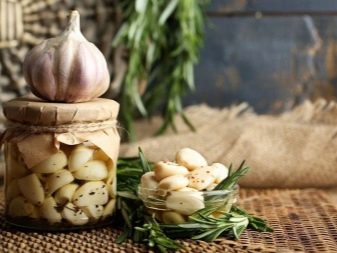
Such a modified stem looks differently, since it can have:
- dark purple;
- pink-purple;
- White;
- yellow color.
Under natural conditions, it is the bulb that allows the garlic to multiply vegetatively. This cultural property was also appreciated by gardeners. The narrow garlic leaves stretch out like a lancet. They have a grooved structure and a keel located below. And also the leaves closer to the tip are pointed. Their length varies from 0.3 to 1 m.
Interestingly, each new leaf grows from the previous one, and thus a "false stem" appears, which is stronger than that of a real onion. The height of the peduncle, commonly referred to as an arrow, ranges from 0.6 to 1.5 m. The garlic inflorescence is a simple umbrella in the shape of a ball. The flowers of such a plant are sterile. In addition to them, in the inflorescence there are breeding bulbs-bulbs, as well as a compacted bedspread. The flowers are supported by long pedicels. The perianth is visually similar to the corolla. The perianth will have 6 petals. They are painted white or lavender. The real fruit of garlic is a box. Seed formation is very weak.
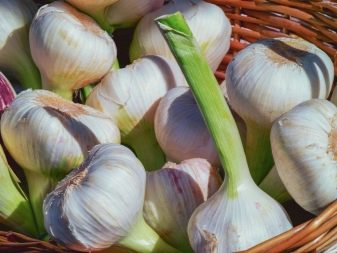
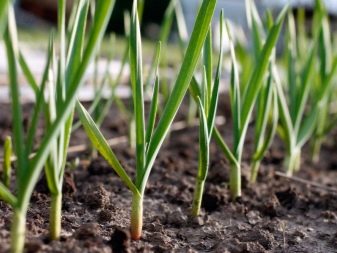
Origin story
The antiquity of the roots of the name indicates that such a vegetable crop in Eurasia was known at least 1000 years before our era. Botanical studies have made it possible to establish that garlic is native to Central Asia (it was there that its wild forms were domesticated earlier than in other places). Later, no significant civilization could do without this bitter, but such useful vegetable. Such a plant was widely known to the ancient Greeks, and Rome also borrowed it.Even earlier, the culinary experts of Egypt and India, as well as China and the Sumerian-Akkadian kingdom, became interested in garlic.
Available sources suggest that this herb was included in the mandatory daily diet of the pyramid builders. Garlic appeared in Russia very early, most likely, when it was still possible to talk about Russia itself only in the future tense. It is possible that it even began to be used before the proto-state alliances of tribes arose. The mention of this culture in the texts of the 13th century is precisely established. Even earlier, it became a full-fledged part of Russian cuisine.
In the Middle Ages, sharp "teeth" continued to be the constant food of the villagers both in our country and in Western Europe. There is no doubt that they have saved tens of thousands of lives in conditions of total unsanitary conditions and continuous epidemics. But in England, according to some sources, garlic appeared only in the middle of the 16th century. But the statements of such sources are extremely dubious, since the corresponding word has been known about 1000 years earlier.

Landing
For all the significance of historical facts, gardeners are keenly interested in much more prosaic things. The timing of planting garlic is determined by its species. Winter types of vegetables are planted in the last third of September and beyond, until mid-October. The calculation is made that the culture should take root thoroughly before frost occurs, but by no means germinate. If this requirement is violated, normal development and a good harvest in the next season will be unattainable. The cultivation of summer varieties should be started as soon as the snow finally melts. Usually it is about early or mid-April. Germination is possible even at a ground temperature of only 6 degrees. It is necessary to do everything so that the heads have time to form before the onset of hot days. If this nuance is overlooked, crop crushing is inevitable.
The choice of open spaces is recommended. Garlic feels good only with active sun exposure.... The width of the ridge should be at least 75 cm. It is advisable to equip 8 cm and higher ridges. This will simplify processing and eliminate unnecessary water accumulation. The row spacing should be at least 20 cm. The gap between individual holes is halved. These proportions are due to the convenience of the subsequent care of the plants. Due to too dense planting, the shoots will compete with each other. In such an environment, it is impossible to count on getting full heads and strong teeth.
The soil in the selected area is dug up 2-3 weeks before planting. Otherwise, it will not have time to settle, and the goal of digging will not be achieved. Autumn preparation is recommended for spring planting of garlic. It is useful to loosen the soil.
Top dressing is preliminarily applied only if the soil is not suitable for the plant in composition. The acidity of the earth can be reduced by traditional liming.
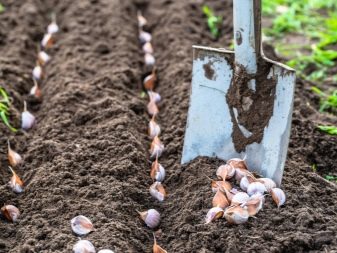
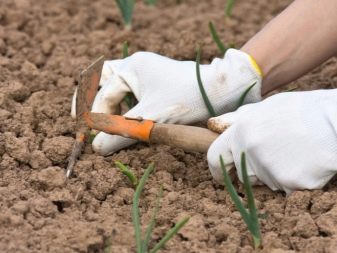
Care
Nitrogen fertilization is recommended immediately after germination. You do not need to delete all arrows. Leaving a few of them, it will be possible to estimate the timing of the development of culture. To keep the plant healthier, it is regularly rejuvenated with air bulbs. When planted in the fall next year, you can get full-sized bulbs from them.
Garlic is very fond of making ash. You can also use slurry. One part of manure is dissolved in 6 parts of pure water. The ground should be constantly wet, but not wet - this line is very important. Watering is usually carried out in the absence of precipitation. Thrown out arrows break off or cut off.
Reproduction
Most often in gardens and vegetable gardens, garlic is propagated by using cloves. The best results are obtained with cloves of winter varieties that have been planted and grown in strict accordance with technology. You should hardly trust the purchased planting material to the same extent.It is advisable to check the health and general condition of the bulbs used. It is useful to disinfect them in a strong solution of table salt.
You can also consider the method of reproduction. with the help of bulbs. Their readiness is achieved against the background of the complete formation of garlic inflorescences. A sure sign is the beginning of the film cracking. The inflorescences are cut off along with the arrows and carefully dried. Bulbs must be kept perfectly dry until spring.
If the option with planting them before winter is chosen, then drying should go within 35-38 days. The optimum condition will then be achieved. The bulbous technique is more attractive than the usual one from the point of view of the safety of varietal qualities. The plants themselves will be healthier and more toned. The sowing of winter varieties in the frosty season is preserved without any problems, but in the spring it will begin to develop noticeably more slowly.

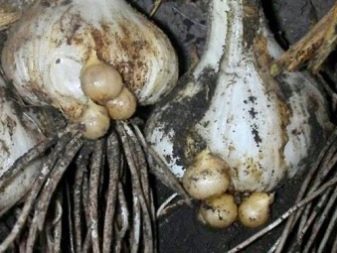
Diseases and pests
The immunity of different types of garlic is not the same. Fungal lesions of this culture can be suppressed by Bordeaux fluid. Rust treatment is also carried out with conventional preparations. But when infected with fusarium, it remains only to burn the plants themselves. Neck and white rot are well defeated when treated with copper sulfate and other fungicides.
In addition to these ailments, viral mosaics and dwarfism, insect pests can also pose a threat to garlic. We are talking about:
- onion moth;
- onion thrips;
- garlic nematode;
- root mites;
- aphids.
They are fought with conventional insecticides.


Collection and storage
The timing of harvesting garlic is determined by its species and varietal affiliation. And it is also required to take into account the current meteorological conditions. The cleaning itself is carried out in the morning or in the evening. Otherwise, the heads will dry out and lose their juiciness. Winter garlic is ready to harvest if:
- inflorescences will begin to burst on the arrows;
- the foliage dries up below, and begins to turn yellow from above;
- the excavated specimens show purple scales.
Spring garlic can be harvested when the leaves have turned yellow or died. Scales of mature heads are thin and dry during test digging. Overripe fruits crack. At the same time, it is very important to forestall the onset of seasonal rains. Digging should be done carefully so that all the fruits remain intact, since any damage can open the way for infection. Dug garlic is advised to dry under a canopy in a draft. The tops of dried specimens are cut off. The largest heads should be used for disembarkation. Air humidity during storage of crops ranges from 50 to 80%. Spring varieties are kept at 16-20, and winter varieties - at 2-4 degrees.
You can keep garlic in glass jars or other glass containers. It is placed in a dry cabinet. Roots are recommended to be burned over an open fire. Burnt onions are often stored as well, sprinkled with flour. It is allowed to put them in boxes, dipping them in paraffin in advance.
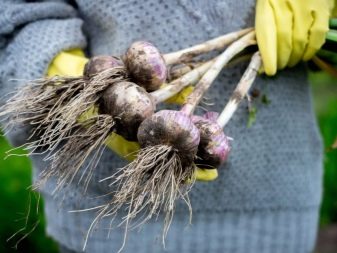
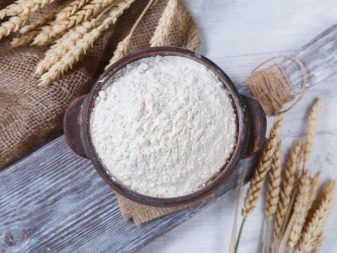













The comment was sent successfully.